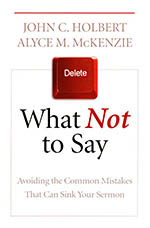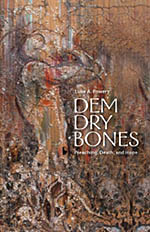Book Reviews: What Not to Say: Avoiding the Common Mistakes That Can Sink Your Sermon by John C. Holbert and Alyce M. McKenzie; and Dem Dry Bones: Preaching, Death, and Hope by Luke A. Powery
John C. Holbert and Alyce M. McKenzie, What Not to Say: Avoiding the Common Mistakes That Can Sink Your Sermon.
(Louisville, KY: Westminster John Knox Press, 2011) 124pp., $14.60

The saying goes, “There’s nothing new under the sun.” Such an adage has plagued both pulpit and pew, as the preaching and hearing of the Word of God have grown accustomed to platitudes. In many cases, the (un)intended result of explicit and implicit messages arise from not taking seriously the theological root and consequent fruit. Holbert and McKenzie do us all a great service by debunking hackneyed, homespun sayings about God, the Bible, and yourself, as well as providing solid exhortation on what not to say in the beginning of sermons, about the congregation, what not to say in the middle of the sermon, how to tell stories right and what not to say at the end of the sermons.
Holbert and McKenzie know the preaching craft and pastoral ministry well. This volume is user-friendly and accessible, bringing chuckles at times, because of the familiarity of what they critique. They gently and graciously diagnose the theological underpinnings of such statements as “God has a plan for you” for its focus on one strand of the Scriptural witness, or one aspect of God, or one aspect of the self.
What the volume seeks is a full-orbed, holistic appropriation of the various treated subjects. For instance, preaching about God should lift up how God works with and through human suffering, not causing it or having to use suffering to shape character. Sermons that use stories should be appropriate to the subject matter, not be in a long string about the preacher. Sermons that include the preacher should not portray the preacher as the continual hero(ine). In other words, the “do’s” and “don’ts” aim at honoring God, people, Scripture, and all the gifts given and entrusted to the preacher for the edification of the gathered community, so that what is communicated at the pulpit engages the community into imagination, into the unfolding vision attested by Scripture, and experienced Sunday through Saturday in the daily grind of people’s lives.
Each chapter ends with helpful questions for reflection for the preacher to examine her/his sermon for the red flags described by this book, in hopes that what become more familiar in our crafting and delivery of sermons are messages that capture the fullness of theology, biblical exegesis, homiletical theory, reflection, and human experience.
Luke A. Powery, Dem Dry Bones: Preaching, Death, and Hope
(Minneapolis: Fortress Press, 2012) 157pp., $15.60.

When we don’t or won’t confront the reality of death and instead seek to be sedated with messages of abundant living and positive thinking, pulpit preaching, particularly in the form of the so-called prosperity gospel, becomes infected with the contagion of “name it-and-claim-it&rdquo,; eliding the real, lived “little deaths” that people confront Sunday through Saturday. Luke Powery’s Dem Dry Bones inoculates preaching and pastoral ministry with the needed dose of reality: the reality of ultimate death, the reality of “little deaths” as we live in the valley of the shadow of ultimate death, while altogether living in the hope of God in Christ through the Spirit.
Powery rightfully critiques prosperity gospel preaching for its lop-sided messaging of positive living and thinking, which advocates for material consumption and material possession as the metrics of faithfulness and being blessed. The danger of prosperity gospel preaching is it does not and cannot account for the trials and tragedies people face, that death does come knocking, where lived reality encounters violence, hunger, sickness, and all other circumstances of the human condition.
Powery’s volume combs the rich literature of African American spirituals as wise, singing guides on the journey. Using the metaphor of the valley of the dry bones from the book of Ezekiel, Powery sees in the spirituals the means by which vacuous and innocuous preaching that ignores the power of death and the power of hope can be infused with the Spirit’s breath and rise to new life. The spirituals—musical sermons—preached. Black bards emerged from the depth of the lived struggle of African American slaves, where death’s shadow and death itself lingered and inhabited. The spirituals sang the message in the slave experience of confronting evil with hope, a hope within the soul of the African American community and spirit. Spirituals were sung not to thecommunity but by and for the community. Spirituals lifted the spirits of oppressed people, drawing upon the lived experience, finding in the struggle and in Scripture what it meant to live in and with death while living in and with hope. Spirituals, like the exodus motif were coded messages of freedom and deliverance from Pharaoh-like slaveholders, finding hope in the eschatological promised land (heaven) and the earthly promised land (the here-and-now). African American spirituals, Powery proposes, provide a theological hermeneutic and a robust homiletic grounded in the interplay of human experience, hope, God, and Scripture.
Spirituals begin with the human condition: exegeting our human experience, the spaces and places where death and “little deaths” are confronted, where sprouts of hope emerge or are emerging. Spirituals lift up hope, the eschatological hope and rays of hope underneath the patina of human struggle. Spirituals don’t talk about God, but more so, speak of God in the present tense. Spirituals lift up Scriptural themes and narratives, not emphasizing every bit and detail of the Scriptural text, but those pieces that speak directly to the human struggle and that can then be amplified to lift up a vision for the community to live in the victory over death.
In the final chapter, Powery lifts up eight practical homiletical strategies on how to preach death and hope, crucifixion and resurrection, a full-orbed Gospel. In all, he calls preachers to be poetic prophets/prophetic poets, employing the full use of such linguistic tools of metaphor, that lift the imaginative spirit of the community to envision and live into new life emerging from a valley of dry bones. In that call, Powery himself and this volume are poetic and prophetic.


